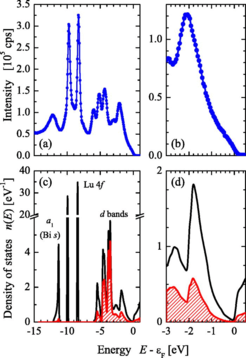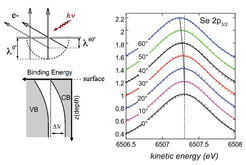Topological Insulators
“zero-gap” Semiconductors
Theoretical predictions in novel material, like topological insulators, are also investigated by HAXPES. The comparison between HAXPES valence band spectra and ab initio calculations shows clear evidence of zero band gap states in C1b Heuslers: LuPdBi, PtYSb and PtLaBi. The zero band gap is resulted from the cubic symmetry and is a signature of band inversion, which is an essential feature for a topological insulator state [1][2].

Figure 1: Valence band of LuPdBi. (a) and (b) HAXPES spectra. (c) and (d) Ab inition density of states, and the density localized at the Pd atoms is marked by the shaded area.
Band bending in Topological Insulator
Theoretical predictions in novel material, like topological insulators and Weyl semiconductors, are also investigated by HAXPES. In this example, HAXPES allows a direct measurement of the surface band bending in Bi2Se3. The existence of a band bending was predicted to be the origin of additional surface states, exhibiting considerable Rashba splitting, nested in the Dirac cone. The band bending was demonstrated by tracking the depth dependence of the core energy shift of the material [3].

Figure 2: EDC for Se 2p3/2 core state. The energy shift indicate a indicates a downward bending from bulk to surface.

